Campo Marzio - new discoveries
1998.04.29
...St. Peter's Basilica and Square match exactly the outline of the Porticus Neronianae and the Temple and Area of Mars complex. The piazza of St. Peter's matches the dimensions of the Area Martis, the Temple of Mars fits within the forecourt of St. Peter's, and the nave and transept crossing of the Neronian Porticus falls right in line with the crossing of St. Peter's. ...so exact, and unquestionably deliberate on Piranesi's part. ...firmly locks the analysis of the life and death axes.
The other discovery deals with the horti Luciliani and the horti Lucullani.
Piranesi places the fictitious horti Luciliani where the horti Lucullani ought to be, and places the horti Lucullani at a location further north.
It is the horti Lucullani that Messalena murdered for.
Lucilius is the father of Roman satire. Is there anything satirical in Piranesi's plan of the garden? Perhaps the answer has something to do with a shrine to Minerva being in the center of one of the building complexes--literally "wisdom" (but also "weaving") in the center of a garden of satire. The theater and salons, now make more sense.
satire 1 a : an ancient Roman commentary in verse on some prevailing vise of folly b : a usually topical literay composition holding up human or individual vices, folly, abuses, or shortcomings to censure by means of ridicule, derision, burlesque, irony, or other method sometimes with an intent to bring about c : LAMPOON 2 a : a branch of literature ridiculing vice or folly
censure 1 : a judgement involving condem-nation a : spiritual chastizement by an ecclesiastical agency
wit implies intellectual brilliance and quickness in perception combined with a gift for expressing ideas in an entertaining, often laughter provoking, pointed way, usually connoting the unexpected or apt turn of phrase or idea and often suggesting a certain brittle unfeelingness
satire can apply to any criticism or censure relying on exposure, often by irony and often subtle, of the ridiclous or absurd qualities of something
The notion of Piranesi being satirical himself throughout the Ichnographia is an intriguing idea.
...the various other gardens and buildings that Piranesi places on the same plateau as the horti Lucullani. Some of them, like the horti Narcissi, relate directly to the Messalena story since it is the freedman Narcissus that ultimately kills Messalena. There is also the horti Anteri--Anteros means "an avenger of slighted love," which describes both Messalena and her husband the emperor Claudius, although for different reasons.
...Tafuri could have said so much more about the horti Luciliani.
Piranesi lives in the "Garden of Satire"
1998.07.07
...since Piranesi came to live at the top of the Spanish Steps, he may then have placed the Horti Luciliani purposefully in the same location within the Ichnographia. If this is so, then Piranesi deliberately places himself (figuratively) within the garden of the father of Roman satire. ...find the exact location of Piranesi's home, check its locationon the Nolli map, and then find the exact location within the Ichnographia. ...not sure if the exact spot will be significant, but it will be good to know nonetheless.
Piranesi lives in the "Garden of Satire" 2
1998.07.07
...I'm not absolutely certain that this is where Piranesi lived in 1757. ...could this be seen as Piranesi directly identifying himself with Lucilian as a "modern" father of Roman satire.
...find out if Piranesi has in other cases made a direct connection between himself, his work and satire. There is one engraving called Satirical vignette against Bertrand Chaupy something where an island(?) is made to look like a turd.
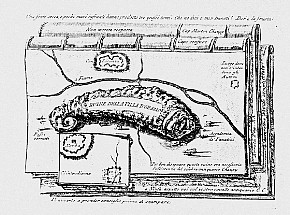
| |
Fathoming the Unfathomable
Stephen Lauf
1998.07.08
fathom b : intellectual grasp, penetration, or profundity : COMPREHENSION
unfathomable : not capable of being fathomed a : INCOMPREHENSIBLE, INSCRUTIBLE [all that is cryptic and unfathomable in humanity --J.L.Lowes] b : IMMEASURABLE, IMPENETRABLE
intrigue 3 : the plot of a literary or dramatic work esp. marked by an intricacy of design or action or a complex interrelation of events
Giovanni Battista Piranesi's Ichnographia Campus Martius is unquestionably a plan full of intrigue. The depth of its detail is equally matched by the depth of its meaning. To understand this plan requires total immersion, even though every aspect of the plan is already completely open to view. Therein lies the Ichnographia's greatest irony -- all the pieces are visibly in place while the overall effect remains a puzzle.
The Encyclopedia Ichnographica is the result, so far, of over a decade's worth of re-drawing and re-search, with the joint goal of both efforts being to lift the Ichnographia's shroud of puzzlement, as well as to finally place Piranesi's plan among architecture's paramount designs. Working with the Ichnographia is still rarely easy, however; the Latin labels throughout the plan do not always translate well, Piranesi's archeological inaccuracies are enduring hurdles, and the ongoing reading of both ancient and modern texts, along with reading and re-drawing the hundreds of plans within the large plan, is continually intense. Nevertheless, the Ichnographia rewards splendidly because, after the removal of many layers of incomprehensibility, Piranesi's large plan delivers numerous double narratives where inversion, if not satire, is the dominant theme. In more concise terms, the Ichnographia comes to represent Piranesi's delineation of ancient Rome's story from beginning to end.
After so many years of being intimately involved with the Ichnographia Campus Martius, it is slightly disconcerting to not know exactly when I first saw the large plan. If memory serves me correctly, my initial knowledge of Piranesi's Campo Marzio plan came with the anecdote of how a copy of the plan hung over Louis I. Kahn's office desk. Even though I now know that Vincent Scully relates this information within his book, Louis I. Kahn, I believe the account of the Ichnographiam hanging over Kahn's desk is something I originally heard in architecture school rather than read, and, since many of the mid-1970s faculty members at Temple University's Department of Architecture were either students of Kahn or had worked in Kahn's office, my assumption is reasonably sound.
Almost as a matter of course, the early years of my architectural education produced a strong personal interest in Kahn's geometric planning, specifically Kahn's unique ability of turning rigorous combinations of simple shapes into elegant plan compositions. Piecing things together, it then seemed obvious that Piranesi's plan of the Campo Marzio was a source of inspiration for Kahn's planning principles. Therefore, if I was to learn how to design like Kahn, I too needed Piranesi's plan for inspiration.
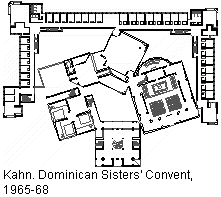 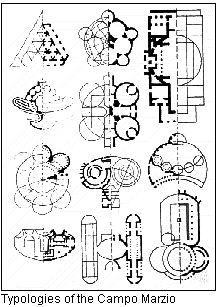
The Ichnographia remained elusive, however. My search through books and journals yielded reproductions of only portions of the plan, or reduced reproductions of the entire plan were near the point of illegibility. Over several years, I was still not able to compile a readable image of the Ichnographia, nevertheless, other factors began to broadened my comprehension of the plan. A group of diagrams labeled Typologies of the Campo Marzio, which appeared in the Summer 1978 edition of Oppositions 13, indicated that an investigation of Piranesi's plans had already occurred, yet the article [George Teyssot (Christian Hubert, trans.), "Emil Kaufmann and the Architecture of Reason: Klassizismus and 'Revolutionary Architecture'" in Oppositions 13 (Cambridge, MA: The MIT Press, Summer, 1978).] that included the 'typologies' offered no explanation of the analysis behind the diagrams. Even so, the diagrams present a clear message regarding a congruous geometry underlying the Ichnographia's individual plans. This finding registered a shift in my overall interest of the large plan so that, rather than wanting to learn about what inspired Louis Kahn's method of designing buildings and drawing plans, I became much more inquisitive as to what inspired Piranesi's distinctive ichnographic method.
The other factor that shifted my interest in Piranesi's Campo Marzio was a Stirling/Wilford building from 1979, which manifestly combined the ideas of typology and collage into a single coherent architectural design, the Wissenschaftszentrum (Science Center), Berlin. This Stirling/Wilford design is certainly a "spin-off" of Kahn's Convent for the Dominican Sisters, yet the Berlin building also clearly introduces a new motif within late 20th century architecture, namely the notion that formal abstraction can also include tectonic shapes that possess distinct architectural and typological associations. Of course, this methodology does not come without irony because the associations rendered through the Science Center design in no way relate to the building's functional program, yet the use of recognizable and comprehensible forms within a building's design still adds a potent element whereby modern architecture is able to deliver a readable message. I saw Stirling/Wilford's new approach as a further extension of the inspiration Kahn initially derived from Piranesi, and my supposition was reinforced by Charles Jencks who, as guest-editor of Architectural Design's 'Post-Modern Classicism,' [Charles Jencks, guest editor, "Post-Modern Classicism -- The New Synthesis," Architectural Design, vol. 50, no. 5/6, 1980, p. 75.] without explanation placed Piranesi's aerial perspective of the Campo Marzio next to a top view photograph of a model of the Science Center.
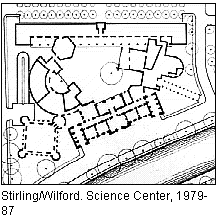 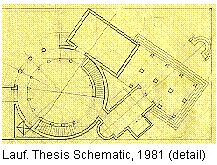
My formal architectural education thus ended in May 1981 with my designing an Institute of Contemporary Art where I explored typology and collage, and, judging from the design's schematic sketches, Piranesi influenced me more than I probably cared to admit at the time. Furthermore, as fate would have it, within weeks of my graduation I found a poster of the Ichnographia in the AIA Philadelphia Bookstore. I immediately purchased the poster, and promptly hung it over my drafting table at home.
|